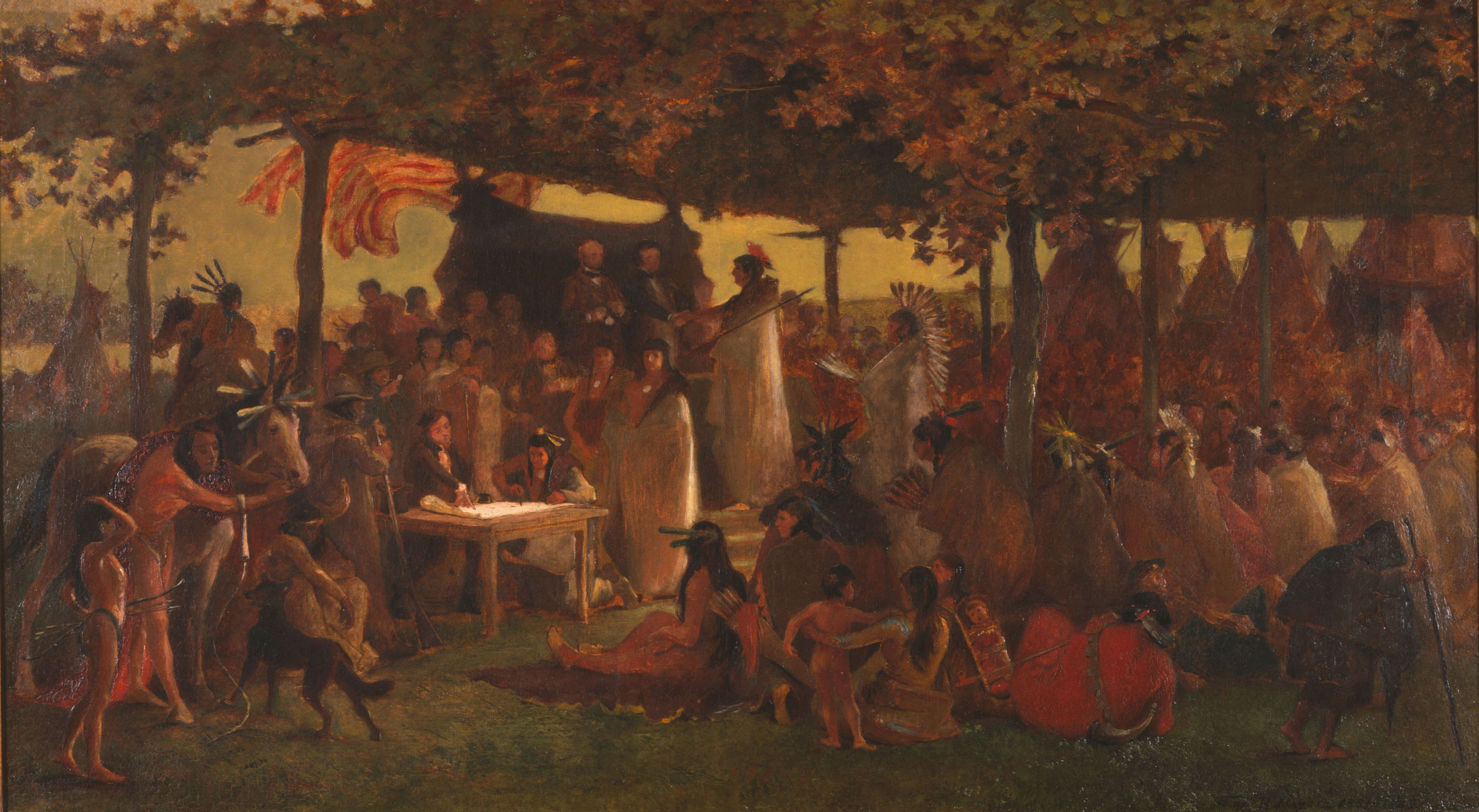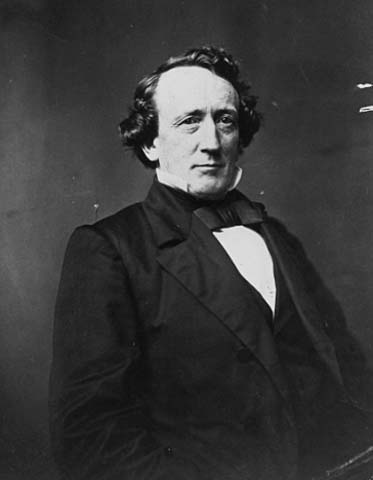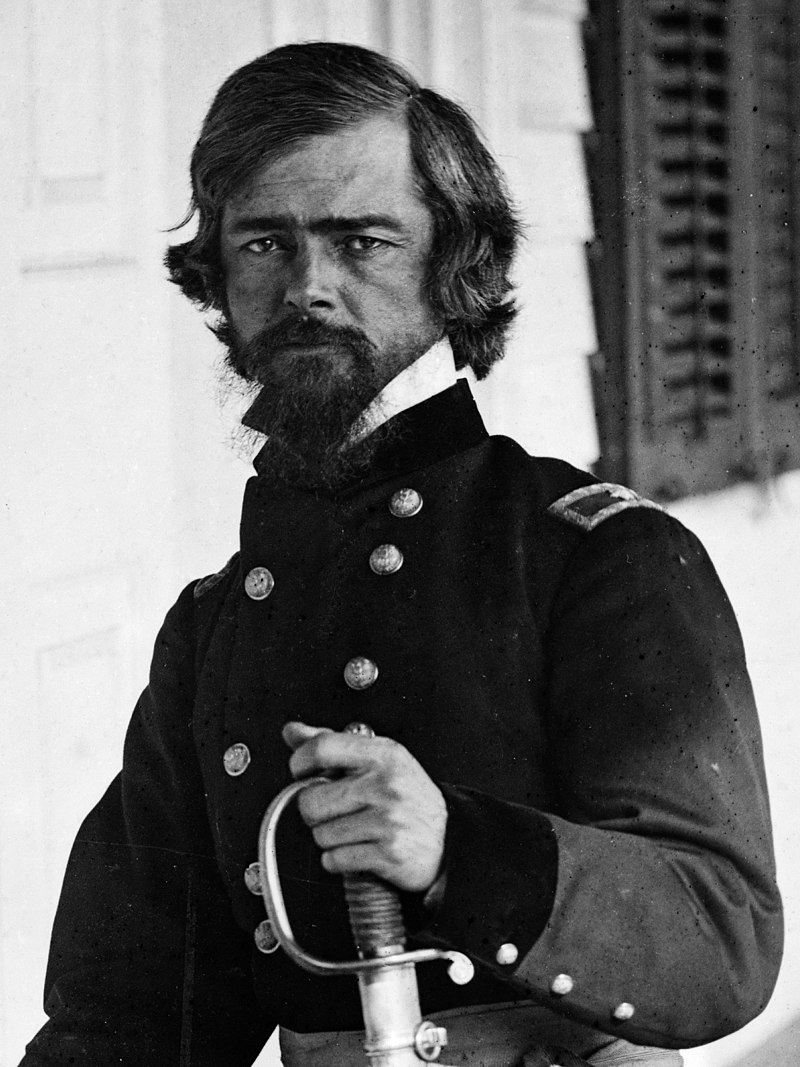Before "Indian Removal" was accomplished in the east, a flaw in the logic behind the plan became apparent. Even as tribes were relocated beyond the western boundaries of white settlement, the boundaries of white settlement moved west to the Pacific Ocean.

In the 1840s and 1850s US claims of dominion expanded rapidly beyond the Mississippi. Texas was annexed and admitted to the Union. The US pressed its clam that land acquisition was its Manifest Destiny through a war with Mexico. The discovery of gold in California and in Oregon drew a rush of miners and speculators, and traffic on the wagon roads to the Pacific Northwest increased exponentially.
This rapid expansion raised the question of who would control the Indigenous lands that the US meant to acquire. Would it be southern slaveholders, or northern railroad owners? The question first came to a head with the passage of the Kansas-Nebraska Act to create a political entity through which railroads might be run. Even as the US negotiated for the cession of a few last reservations in Ohio, it was forcing large scale land cessions all the way to Washington and Oregon.
Targeted Reservations, 1840-1843
By 1840, the land base of the Miami, Delaware and Wyandot nations in the east was reduced to reservations in Indiana, Ohio and Michigan, which then became the target of US land cession treaties. A treaty with the Miami in Indiana was negotiated by Allen Hamilton, a trader who corresponded with politicians about how personally to gain money and land from treatymaking; and Indian agent Samuel Milroy, who had been selling town lots 35 miles from the reservation for more than a decade. Two of Milroy’s sons also signed the treaty. At Upper Sandusky in 1842, the Wyandot ceded reservations in Ohio and Michigan. US treaty signers included Joseph Chaffee, who was already squatting on Wyandot land; Stephen Fowler, who had already laid out the town of Little Sandusky; William Buell, who would lay out the town of Carey, Ohio just north of the treaty site the next year; and John Carey, for whom that town would be named. In 1843, the Wyandot agreed to provide part of their new Kansas reservation to facilitate the final removal of the Lenape Delaware.
Seneca 1842 and 1857
A treaty with the Seneca in 1842 was negotiated with Ambrose Spencer, a Quaker who championed state control over Indigenous people (and whose son was Secretary of War). The treaty, which gave Thomas Ogden and Joseph Fellows the right to buy a Seneca reservation, was written and signed by Spencer and other Quakers. Ogden and Fellows immediately ejected the Seneca from the reservation, leading to a Supreme Court case that proved Ogden and Fellows to be in the wrong. In 1857 the Seneca purchased back some of their land in a treaty where the signers included no Quakers but did include the white lawyers of the Seneca nation.
Iowa and Wisconsin, 1842
At two significant land cession treaties in 1842, fur traders and land speculators maintained their prominent roles in treaty making. An Ojibwe cession of a large tract in northern Wisconsin and the Upper Peninsula in Michigan was negotiated by Robert Stuart, who by then ran the American Fur Company. The treaty awarded $75,000 to pay for debts to traders. Men who signed the treaty (traders Warren, Beaulieu, Borup, Oakes, and Aitkin, and their attorney Zephaniah Platt) are mentioned by name as direct recipients of US funds. In the same year, Iowa governor John Chambers negotiated removal of the Sauk and Fox from Iowa to Kansas. Speculator and fur trader Antoine Leclaire signed this treaty, as he did most of the Sauk and Fox treaties of this era. Another signer was agent John Beach, who had expelled squatters from Sauk and Fox land until the land cession was made.
Western Cessions and Boundaries, 1845-1856
Changes in federal policy and emigration in the West resulted in a number of treaties that affected the land base of tribes in Kansas, Nebraska, Iowa and the Dakotas. Commissioners for these treaties ranged from T. P. Andrews (Potawatomi Nation 1846), who had investigated fraud in earlier US-Indian treaties, to D. H. Cooper (Choctaw Chickasaw 1854), who personally misappropriated $134,000 from the Choctaw. The treaties were signed by traders (e.g. Charles Chouteau and Seth Hays, who benefitted from increased traffic by emigrants; A. P. Wilson, a sutler who made money at army forts); missionaries; and long-term clerks in the War Department. Among the signers were also current and former Governors and US Congressmen, plus attorneys for Indigenous nations (J. B. Luce, George Paschal), who engaged in land speculation, using their proceeds from Indian Affairs to buy land in Texas. Some of the biggest con men in the history of US-Indian relations were also among the engineers of these treaties, including Samuel Stambaugh, William W. Dennison (who pocketed $40,000 meant for annuity payments before joining the Confederacy), and most notably Perry Fuller. A Ponca land cession in present-day South Dakota was signed by members of a cabal of lawyers and Interior Department clerks who aimed to secure a fortune by representing Indigenous nations in suits against the federal government (Edward Hanrick, E. B. Grayson).
Annexation and War, 1846-1853
In the 1846 run-up to the US war with Mexico, the US attempted to secure the neutrality of the Comanche people – long time antagonists of Texas. Two political appointees (P. M. Butler, former governor of South Carolina and newly-appointed Indian agent, and Micajah Lewis, who would be fired as a negotiator by James Polk the next month) were commisioners for an 1846 treaty with Comanche. With no practical experience themselves, they relied on agents who had until recently worked for the Republic of Texas (E. Morehouse and Robert Neighbors) and established traders on the Santa Fe Road (Louis Sanchez, John Conner, Isaac Duval). Just after the War, a military expedition led by New Mexico military governor Col. J. H. Washington, while exploring a trade route to Santa Fe, negotiated a “peace treaty” with the Navajo, but US forces opened fire on the Navajo delegation in a dispute over a stolen horse. The US maintained a strong military presence in the Southwest for years after the Treaty of Guadelupe Hidalgo which ended the War with Mexico, because the US in that treaty assumed the costly responsibility of “restraining” and “punishing” raids into Mexico by Indigenous nations, particularly the Apache. A treaty between the US and the Apache was negotiated by E. V. Summer, a colonel with “contempt for civilian authority” who had not yet learned that he had been fired as commander of the 9th (Southwestern) US military district. US military leaders relied on “mountain men,” fort sutlers and other traders, including a former owner of Fort Laramie, to negotiate treaties.
Minnesota and Wisconsin Land Exchanges, 1846-1856
 In the 1840s, the US pursued a plan to move Ho Chunk and Menominee people from Wisconsin, and secured two land cessions from the Ojibwe in present-day Minnesota for this purpose. The US also attempted to move the Stockbridge Munsee band to a reservation on the Menominee land in Wisconsin, over opposition from the Menominee. The Menominee never moved to Minnesota and ceded land there to the US in 1854; in 1856 they ceded of a small tract from their Wisconsin reservation to the Stockbridge Munsee. The Ho Chunk did relocate, but in 1859 moved from central to southern Minnesota. In the midst of this movement the US continued to concentrate the Ojibwe on reservations in Minnesota, through land cessions of significant size. In all of these negotiations, traders, miners, and land speculators with political ties played a prominent role. Signers included trader/politician Henry Rice, copper miners J. W. Lynde and Daniel Cash, and many fur traders: Hercules Dousman: Lemuel Goodell: the Ashman, Beaulieu, and Warren families: and six members of the trading Grignon family. The Arrowhead region of Minnesota was ceded in 1854; copper mining interests were represented at the treaty by signers that included J. W. Lynde and Daniel Cash. The next year, a tract in central Minnesota was ceded at a treaty where white traders exerted economic and political pressures; they included Henry Rice and the Ashman, Beaulieu and Warren families. In the 1840s, the US pursued a plan to move Ho Chunk and Menominee people from Wisconsin, and secured two land cessions from the Ojibwe in present-day Minnesota for this purpose. The US also attempted to move the Stockbridge Munsee band to a reservation on the Menominee land in Wisconsin, over opposition from the Menominee. The Menominee never moved to Minnesota and ceded land there to the US in 1854; in 1856 they ceded of a small tract from their Wisconsin reservation to the Stockbridge Munsee. The Ho Chunk did relocate, but in 1859 moved from central to southern Minnesota. In the midst of this movement the US continued to concentrate the Ojibwe on reservations in Minnesota, through land cessions of significant size. In all of these negotiations, traders, miners, and land speculators with political ties played a prominent role. Signers included trader/politician Henry Rice, copper miners J. W. Lynde and Daniel Cash, and many fur traders: Hercules Dousman: Lemuel Goodell: the Ashman, Beaulieu, and Warren families: and six members of the trading Grignon family. The Arrowhead region of Minnesota was ceded in 1854; copper mining interests were represented at the treaty by signers that included J. W. Lynde and Daniel Cash. The next year, a tract in central Minnesota was ceded at a treaty where white traders exerted economic and political pressures; they included Henry Rice and the Ashman, Beaulieu and Warren families. For an article on the Ojibwe land cession treaty of 1854, see "They Would Not Be Moved" (Edmund Danziger, Minnesota History, Spring 1973) here.
|
White Emigration, 1848-1851
The California gold rush, Mormon migration, and opening of Oregon to white settlement exponentially increased travel by US emigrants in the west during the 1840s. The US sought to secure emigrant passage and build forts through problematic treaties with the Pawnee in 1848, with the Utes in 1849, and most notably with multiple nations at Fort Laramie in 1851. While the US military was present at all of these treaties, a prominent negotiation role was held by traders who had already become rich by supplying forts and wagon trains, including Edmond Chouteau of the well-established Chouteau family, Thomas Fitzpatrick, Robert Campbell, and many others.
Dakota, 1851-1858
In two of the more infamous treaties in US history, the Mdewakanton, Wahpekuta, Sisseton and Wahpeton peoples (members of the Seven Council Fires) ceded the southern third of present-day Minnesota in 1851. Cronies of treaty negotiators Alexander Ramsey and US Commisioner of Indian Affairs Luke Lea received tens of thousands of dollars of the compensation for this cession. These signers included Hercules Dousman who also represented his partner Henry Sibley, and Richard Chute representing the Ewing brothers. A narrow Dakota reservation along the Minnesota River then became the target of white settlement. By 1858, a land cession treaty for half of the reservation was negotiated by trader Joseph R. Brown and his brother, who owned a townsite development company. Also in 1858 the Yankton people (another member of the Seven Council Fires) ceded land in present-day South Dakota, in a treaty engineered by another group of traders including J. B. S. Todd, who turned their trading posts into town sites.
Palmer/Stevens Treaties, 1853-1855
 With the creation of Oregon Territory in 1848, white emigration to the Pacific Northwest increased. Territorial Governor Joseph Lane negotiated a peace treaty with Indigenous peoples there in 1853, but with the creation of Washington Territory that year, US territorial acquisition became more aggressive. Isaac Stevens (who took a side job as surveyor for a railroad on his trip west to become Washington Territorial Governor) antagonized Indigenous nations to such an extent that even white settlers came to oppose his policies; he had an entire town and a territorial supreme court justice arrested. Though reprimanded by the federal government for their high-handed policies, Stevens and Joel Palmer, the Oregon territorial Superintendent of Indian Affairs, depended on white supremacist militia groups to force more than 15 land cession treaties in two years, leading to decades of armed conflict in the region. A group of steamboat entrepreneurs often in business with Indian agent M. T. Simmons also signed the treaties. Of the 196 signatures on all of these treaties, more than half were made by 20 men in Stevens' personal circle, though even several of these allies came to oppose Stevens’ policies. With the creation of Oregon Territory in 1848, white emigration to the Pacific Northwest increased. Territorial Governor Joseph Lane negotiated a peace treaty with Indigenous peoples there in 1853, but with the creation of Washington Territory that year, US territorial acquisition became more aggressive. Isaac Stevens (who took a side job as surveyor for a railroad on his trip west to become Washington Territorial Governor) antagonized Indigenous nations to such an extent that even white settlers came to oppose his policies; he had an entire town and a territorial supreme court justice arrested. Though reprimanded by the federal government for their high-handed policies, Stevens and Joel Palmer, the Oregon territorial Superintendent of Indian Affairs, depended on white supremacist militia groups to force more than 15 land cession treaties in two years, leading to decades of armed conflict in the region. A group of steamboat entrepreneurs often in business with Indian agent M. T. Simmons also signed the treaties. Of the 196 signatures on all of these treaties, more than half were made by 20 men in Stevens' personal circle, though even several of these allies came to oppose Stevens’ policies.
Manypenny Treaties, 1854-1856
In 1851, Commissioner of Indian Affairs Luke Lea developed a policy towards Indigenous nations that called “first, for their concentration; secondly, for their domestication.” His successor, George Manypenny, pursued the policy wholeheartedly. He signed treaties with the Ojibwe and Ho-Chunk in 1855 (mentioned earlier), plus another 15 treaties during his two year tenure, and oversaw the negotiation of scores of other treaties, including the Palmer / Stevens treaties in the northwest. Many of the treaties in the Manypenny era were spurred by the Kansas-Nebraska Act of 1854, which accommodated white emigration into “Bloody Kansas” in the run-up to the Civil War and prepared the way for a transcontinental railroad. Copper mining was represented among US signers of Ojibwe treaties; traders, missionaries and townsite developers signed treaties from Michigan to Kansas. |
